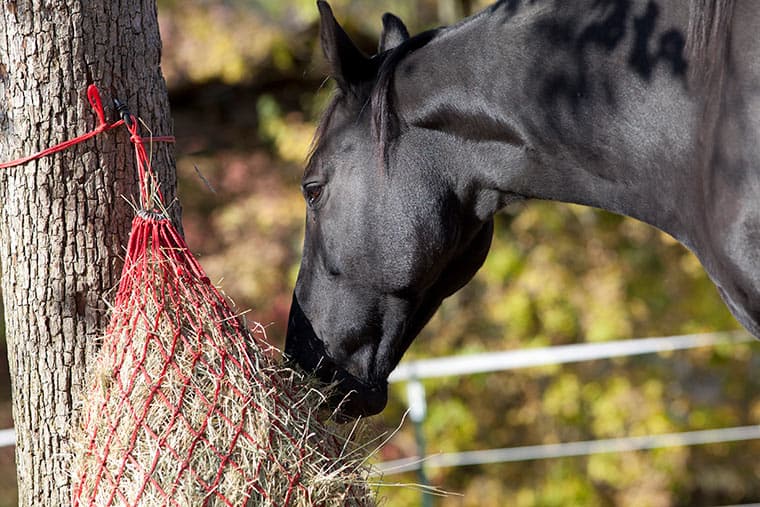Hay-Feeder Height Affects Neck, Back, and Jaw Postures

“We know that when riding horses, there are different kinds of postures that can affect their health and welfare,” said Emanuela Valle, DVM, PhD, ECVCN, head of the clinical nutrition counseling group in the University of Turin’s Department of Veterinary Science, in Italy. “But what about when we’re feeding them? Posture is related to how the spine is aligned, and it’s important to consider how our management affects it.”
The Study
As slow feeders gain in popularity, effectively keeping horses busily eating for longer periods of the day to improve their health (including reducing gastric ulcer risk) and welfare, a new issue of eating-related posture is emerging, said Valle. Although many owners and professionals have suspected feeding height and position matter, researchers had yet to investigate haynet height’s effects on horses’ back and neck shapes.
So Valle and her colleagues observed six Warmbloods, averaging 14 years old, as they ate hay from:
- The ground;
- A haynet set low at about knee level, creating a neck level about 15 degrees below the withers; and
- A haynet set high at about 15 degrees above the withers.
Using video recordings, the researchers obtained shape data from the horses’ backs and necks as they ate at each level. Then they compared the shapes by superposing them onto each other.
They found that the low haynet position resulted in back positions that were almost the same as the natural position when horses ate off the ground, with elongated longissimus dorsi muscles (which run along each side of the horse’s back and under where the saddle sits), Valle said.
At the high haynet position, the horses’ back positions changed significantly, shortening the muscles.
The angle made between the horse’s jawline and neckline when eating is perhaps equally important, Valle said, noting that as the horse’s neck raised, that angle closed more and more, leading to acute and highly unnatural eating angles at the highest level.
“Both (off-the-ground) positions changed neck posture and the mandibular (lower jaw) angle, with extreme values reached when then neck was maintained above the withers,” Valle told The Horse.
Important Notes About Haynet Use and Horse Safety
Considering how much time horses spend eating from haynets, it’s important to be cognizant of the bodily positions the feeders impose, Valle said. Although the team hasn’t yet studied how these unnatural feeding positions affect the horses’ health, Valle said she suspects a natural feeding position is better both for the musculoskeletal system and the digestive system.
Owners and horse managers should also ensure horses’ shoes and legs can’t get caught in haynets. The low haynet position the scientists used in this particular study is too low to be used safely in daily horse management—although in a laboratory setting that height provided important information about how feeding from a device set below the withers affects the head and neck, Valle said.
Owners should consider multiple aspects of haynet positioning when it comes to their horses’ safety, Valle added. “Watch where your horse likes to roll, and be sure you never tie the haynet in the corner where his feet go when rolling,” she said.

Written by:
Christa Lesté-Lasserre, MA
Related Articles
Stay on top of the most recent Horse Health news with















